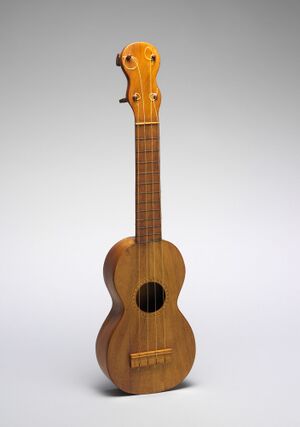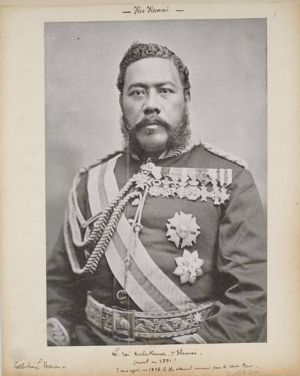PHYS341/2024/Project32
Ukulele Strings
The Ukulele

The ukulele is a string instrument that has its origins in the lute family. It typically has four strings which are most often made from nylon. Often referred to as the “uke” it is mainly associated with music from Hawaii. In its standard form it will come in four sizes being Soprano (21 inches tall), Concert (23 inches tall), Tenor (26 inches tall), Baritone (29 inches tall). Outside of these main varieties which provide varying differences on a similar sound you have bass ukulele’s which are like what bass guitar is to a standard guitar.
Other than these differences in size a ukulele is often made in a similar way and almost mimics the makings of a standard acoustic guitar. The ukulele has distinct parts of a body, bridge, neck, fretboard, nut, headstock, and tuners with a large sound hole in the middle of the body like that of an acoustic guitar.
Historical Background

With its associations of carefree attitudes and the soothing background sounds of some sort of tropical destination, the Ukulele (unlike most common instruments) carries a distinct aesthetic and feel to its sound. Originating originally from the Lute the Ukulele would be introduced to the people of Hawaii through Portuguese immigrants [1] . This popularization would also be caused by the backing of the instrument by Kalakaua the King of the Hawaiian Islands during the time of the Ukulele’s introduction [2]. Kalakaua even went as far as having his own band called “Kalakau’s Singing Boys” who would sing and play the ukulele with Kalakau for high-profile visitors in Hawaii[3]. These factors lead to the soft strums of the “Uke” becoming the sound of Hawaii helping to foster the more fantastical image we have of the islands today.
In Popular Music
Within popular music, the Ukulele would be used quite frequently throughout the 60s and 70s with artists such as Elvis Presley taking a liking to it on songs such as “Can’t Help Falling in Love”. Notably, The Beatles all had fascinations with the Ukulele with Paul McCartney and George Harrison both taking quite a liking to the instrument. The strums can be heard prominently on McCartney’s song “Ram On” while Harrison was known for carrying around a Ukulele throughout the later years of his life having fallen in love with not just the Ukulele but also the sounds of Hawaiian slack-key guitar[4].
In contemporary pop music, the Ukulele would see a resurgence with the rise of YouTube with the small and easy-to-learn instrument being the backing to many song covers. This newfound interest in the Ukulele also started to be reflected within the pop charts with ukulele-driven songs like “Hey Soul Sister” By Train and “I'm Yours” by Jason Mraz both becoming massive chart successes prominently featuring the ukulele.

Types of Strings
Ukulele strings originally were primarily made from intestines. These strings would be known as “cat gut” strings and unlike the name suggests the “cat” refers to cattle. Sheep or Cow intestines were used to create cat-gut strings and would be what would be used for the earliest ukuleles[5]. The use of gut strings over something like steel was because steel put too much tension onto the head stock of the ukulele because of its shorter scale [5].Gut strings due to the lack of materials during WWII and the overall aversion to using animal products for strings were phased out for other materials like nylon [5]. Nylon strings would become common for many types of string instruments including the ukulele. Some string manufactures have tried to make “Nylgut” strings which try to create a synthetic version of gut strings to capture their warmer authentic sound.

Nylon Strings
Nylon is the most used material to make ukulele strings. They were established after the use of gut strings became somewhat controversial, being made from the intestines of real animals. For this example, I’ll be plucking an open C note on the 3rd string. The nylon string being played has a gauge of .032. The nylon string graph shows the two dominant peaks are around 250hz and 500hz with notable peaks ending around 2500hz. The range of pure tones is wide however other alternatives can produce a sound that people find to be richer.
Nylgut Strings

Authentic gut strings are difficult to find only from being made by specialty manufacturers in today’s market. For sake of convenience to compare standard nylon I’ll be using the synthetic amalgamation of nylgut strings. For this example, I’ll be plucking an open C note on the 3rd string. The nylgut string being played as a gauge of .029. The spectrum graph for the nylgut string shows a wide range of pure tones with notable spikes up until around 3000hz. The preference towards gut strings is usually cited to be because of their warmer sound that is often richer and more complex than nylon. The wide range of tones in the spectrum graph show that the nylgut do offer a synthetic alternative than the real thing.
Conclusion
While the standard nylon strings service the ukulele and many contemporary string instruments very well the original authentic sound of gut strings is one sought after. The synthetic nylgut strings while still nylon is treated like gut strings creating a sound that is arguably richer than nylon. Nylon specifically for an instrument like the ukulele has been an essential advancement for strings as materials like steel just don’t fit the ukulele’s physical shape or sound. Nylon has helped to sustain the ukulele’s legacy capturing the breeziness keeping the instruments unique charm intact that made the likes of Kalakaua fall in love with the instrument.
References
- ↑ King, John (August 3rd, 2004). "Prolegomena to a History of the Ukulele". Ukulele Guild. Retrieved April 13th, 2024. Check date values in:
|access-date=, |date=, |archive-date=(help) - ↑ "Ukulele Hall of Fame - David Kalakaua". Ukulele Hall of Fame Museum. Retrieved April 13th, 2024. Check date values in:
|access-date=(help) - ↑ King, John. "UKULELE YES!". Tales of Hawaii. Retrieved April 13th, 2024. Check date values in:
|access-date=(help) - ↑ Jackson, Blair. "How The Beatles' George Harrison Turned His Love of Ukulele into a Personal Crusade". Ukulele Magazine. Retrieved April 13th, 2024. Check date values in:
|access-date=(help) - ↑ 5.0 5.1 5.2 Nagyszalanczy, Sandor. "Vintage Ukulele Strings A Look at the Packaging and Materials". Ukulele Magazine. Retrieved April 13th, 2024. Check date values in:
|access-date=(help)